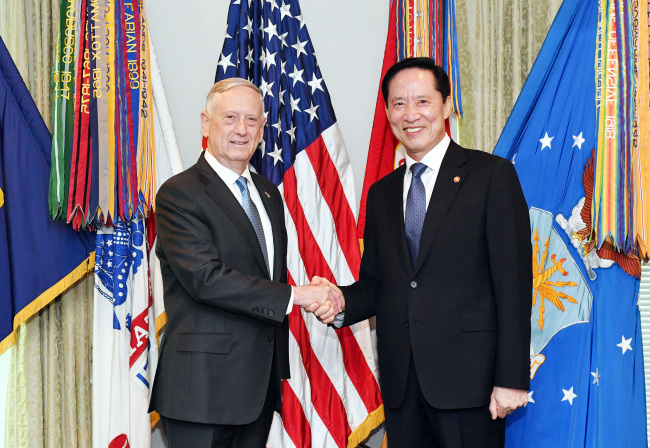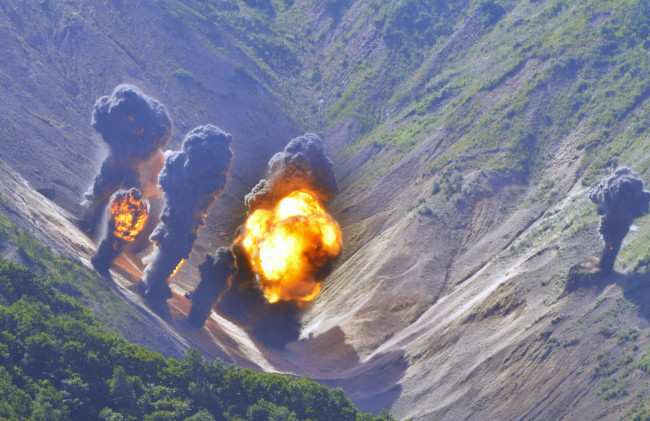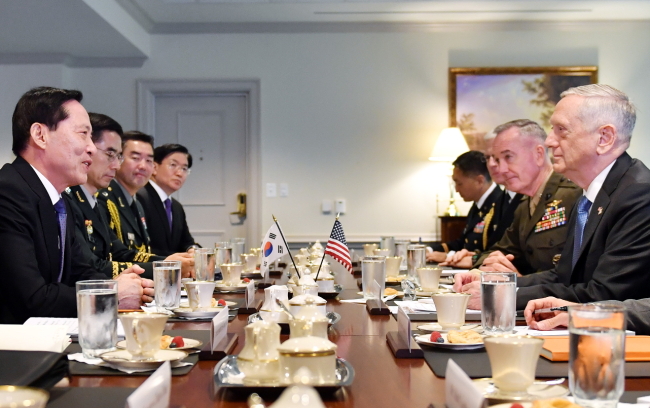Talk of South Korea’s nuclear armament resurfaced Thursday, after Seoul’s defense chief raised the issue in a meeting with his US counterpart.
Meeting US Defense Secretary James Mattis on Wednesday, Seoul’s Defense Minister Song Young-moo floated the idea of South Korea manufacturing indigenous nuclear-powered submarines and bringing back US tactical nukes that were withdrawn from the Korean Peninsula in 1991.
The proposal was discussed in the context of the allies’ efforts to enhance their deterrence against escalating threats from North Korea, which hurled an intermediate range ballistic missile over Japan on Tuesday and had fired short-range missiles two days earlier.
The government, however, sought to quell the speculation, with the Foreign Ministry saying South Korea continues to observe the current nuclear-free principle and the Defense Ministry downplaying Song’s remark as an “introduction” of calls for nuclear armament here.
“I don’t think it was a serious discussion,” Vice Defense Minister Seo Joo-seok told lawmakers Thursday at the National Assembly. “My understanding is that the South Korean and US defense ministers only mentioned such ideas (of redeploying US tactical nukes and developing nuclear submarines).”
Meeting US Defense Secretary James Mattis on Wednesday, Seoul’s Defense Minister Song Young-moo floated the idea of South Korea manufacturing indigenous nuclear-powered submarines and bringing back US tactical nukes that were withdrawn from the Korean Peninsula in 1991.
The proposal was discussed in the context of the allies’ efforts to enhance their deterrence against escalating threats from North Korea, which hurled an intermediate range ballistic missile over Japan on Tuesday and had fired short-range missiles two days earlier.
The government, however, sought to quell the speculation, with the Foreign Ministry saying South Korea continues to observe the current nuclear-free principle and the Defense Ministry downplaying Song’s remark as an “introduction” of calls for nuclear armament here.
“I don’t think it was a serious discussion,” Vice Defense Minister Seo Joo-seok told lawmakers Thursday at the National Assembly. “My understanding is that the South Korean and US defense ministers only mentioned such ideas (of redeploying US tactical nukes and developing nuclear submarines).”

Mattis’ response has yet to be confirmed. Washington has previously opposed the measure out of concern it would prompt backlash from China and Russia and deepen an already-intense arms race in Northeast Asia.
Since taking office in July, Defense Minister Song has hinted at pursuing the development of a nuclear-powered submarine. On Aug. 1, days after North Korea launched an intercontinental ballistic missile capable of hitting the contiguous US, Song said Seoul was “ready” to consider the development.
Pyongyang’s successful ICBM launch and ensuing missile provocations have also prompted calls to bring back US nuclear weapons, particularly among conservative opposition parties who criticized President Moon Jae-in’s approach of engaging with North Korea in dialogue to address its military threats.
The Moon administration has thus far remained skeptical of redeploying US tactical nukes, saying the move would violate Seoul’s previous pledge to stay nuclear-free in 1991. Seoul is also banned from developing nuclear weapons under various international agreements, including the Non-Proliferation Treaty.
“The government’s basic position is denuclearization of the Korean Peninsula by ensuring North Korea completely abandons its nuclear weapons,” Foreign Ministry spokesman Cho June-hyuck said in a press briefing Thursday.
Given the diplomatic and institutional hurdles facing efforts to deploy nuclear weapons, Song’s remark appeared to be in line with pressure on Washington to send more strategic assets and honor its commitment to providing extended nuclear deterrence, analysts said.
On Thursday, the US deployed its stealth fighters and strategic bombers to take part in bombing drills aimed at North Korea. Two US B-1B supersonic bombers and four F-35 stealth fighter jets joined four South Korean F-15 fighters in live-fire exercises at a military field in eastern South Korea that simulated precision strikes against the North‘s “core facilities,” an official from Seoul’s Defense Ministry said.

The show of force came as the allies are wrapping up their annual computer-based military exercise known as Ulchi Freedom Guardian, where some 50,000 South Korean and 17,500 US troops simulate a war with North Korea, including the allies’ pre-emptive strike scheme against the North’s nuclear and missile sites.
During their first meeting in Washington, Mattis and Song vowed to push for the relaxation of a bilateral agreement that limits the range and payload of South Korean ballistic missiles and to ensure the prompt transfer of wartime operational control from the US to South Korea.
The allies’ defense chiefs also pledged their support for diplomatic efforts to denuclearize the North, while highlighting that coming up with “strong and effective” military plans would enhance the reliability of the diplomatic approach, according to the Ministry of National Defense.

The agreement came after controversial remarks from US President Donald Trump, who declared that talking to North Korea is “not the answer” to resolving the nuclear standoff, downplaying the effectiveness of diplomatic outreach to Pyongyang in curbing the regime’s military threat.
“The US has been talking to North Korea, and paying them extortion money, for 25 years. Talking is not the answer!” Trump tweeted Wednesday, a day after he had stated “all options are on the table” to fend off North Korea’s military threats.
The US president’s remark, however, appeared to clash with efforts from his cabinet and top military generals, who described a diplomatic approach as a viable option to prevent further provocations from the North.
When asked if there was no diplomatic option for North Korea, Mattis, who met with Minister Song at the Pentagon, indicated that there still was, saying the Trump administration is “never running out of” diplomatic solutions.
By Yeo Jun-suk(jasonyeo@heraldcorp.com)











![[Today’s K-pop] BTS pop-up event to come to Seoul](http://res.heraldm.com/phpwas/restmb_idxmake.php?idx=644&simg=/content/image/2024/04/17/20240417050734_0.jpg&u=)




![[KH Explains] Hyundai's full hybrid edge to pay off amid slow transition to pure EVs](http://res.heraldm.com/phpwas/restmb_idxmake.php?idx=652&simg=/content/image/2024/04/18/20240418050645_0.jpg&u=20240419100350)

